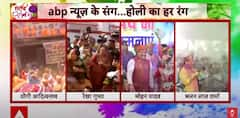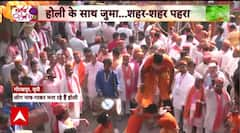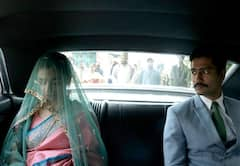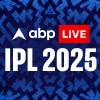Flashback Friday: Naseeruddin Shah, Shabana Azmi Film ‘Paar’ A Must Watch In Current Political Climate
Starring Naseeruddin Shah, Shabana Azmi, 'Paar' got him the Volpi Cup at 1984 Venice Film Festival. Why we mention this is because no Indian actor since then or before that, ever won that title again

- Naseeruddin Shah turned 73 on Thursday. As everyone celebrated his hard-to-match legacy, we took a moment to revisit important chapters of filmography which created many India cinema defining moments; and we found a gem of a movie 'Paar'. Starring Naseeruddin Shah, Shabana Azmi, 'Paar' got Naseeruddin Shah a Best Actor National Award and also the Volpi Cup for Best Actor at the 1984 Venice Film Festival. Why we mention the Volpi Cup is because no Indian actor since then or before that, ever won that title again. That's a legacy unmatched!
New Delhi: Isn't violence so commercial and visceral today? Filmmakers around the world have almost exploited and violated the premise of the Theatre of Cruelty movement( a form of theatre developed by Antonin Artaud which in the simplest terms meant an assault on the senses of the audiences by the artist). In the last few years, in Hindi cinema alone, the portrayal of violence has changed drastically.
Now, blood, gore, mental and physical forms of violence are not suggested on screen but are shown with the most minutest detail. Sometimes, as audiences, one gets a feeling that it is a scavenger race out there; about who gets the bloodiest scene right so as to impregnate the mind of the viewer about how effective the film/series is.
However, back in the 80s in India, in 'Paar' and many other films that were part of the Indian parallel cinema, violence was suggestive and yet, the effect achieved profound.
'Paar' plot
'Paar' is a story about casteism. In the Goutam Ghose directorial, Naseeruddin Shah ( Naurangia) and Shabana Azmi(Rama) play a couple from the marginalised section of society in rural Bihar in the 80s, who escape the village after a night of ghastly violence that kills unarmed civilians. This happens after four members of the lower caste( including Naurangia) kill an upper-caste man responsible for the death of a village schoolmaster.
'Paar' is a subtle take on all forms of violence.
In the first movement, 'Paar' is an exposition into the life of the marginalized section of the society which has suffered since centuries at the hands of the upper class & caste in India.
And, in the second movement( half), 'Paar' takes you on an intimate journey into the lives of Naurangia and Rama.
In this regard alone, 'Paar' is such a commendable balance of the macro and microcosm of the sufferings of one section of marginalised society.
Experiment with form in 'Paar'
'Paar' is such a layered text as far as the experiment with form ( image & sound) is concerned.
Use of still photography, newspaper article readings and text on screen is done to bring out the story of violence in the village.
This is done in the most observational manner without a colouring of intentions.
The empathy is there from the start, but never in a manner that makes any idea, a propaganda.
Visuals of violence happening in the darkness of night and in a suggestive manner in most cases is actually a smart move; one, it does away the need to ace action sequences right for an indie film production, second, it is even more suggestive about the level of violence inflicted and leaves the rest to the audience's imagination.
Among the many scenes; one that stays in the mind is the image of spectacle dangling from a tall flowery plant as the school master dies in another corner of a field.
There is also a use of mid shots when there are scenes involving divulging information about the horrors of casteism. Nowhere does Ghose take an intimate, involved approach in such scenes which involve Om Puri ( village pradhan, in special appearance).
However, mostly in the second half, as mentioned earlier, Ghose takes a more intimate approach with the use of closeups to bring out the suffering of Naurangia and Rama in Calcutta.
There are closeups on Rama and Naurangia's face in the most dire of situations. Towards, the climax of 'Paar', as the two wait for an employer on the ghat of Ganga, we are shown a couple of closeups of sweat trickling down, eyes of lost hope, ants and bees humming and scourging their naked feet in the mud and that is more than anything to suggest their actual plight in the film. A scene that stays long after you have seen the film.
Another notable mention is the non-linear narrative structure, so well-achieved and cut with differing timelines in 'Paar', sometimes complemented by the use of hauntingly sad melodies.
Performances of Naseeruddin Shah, Shabana Azmi in 'Paar'
Both actors ace their parts and while in some places Shah's accent looks slightly off, his performance makes up for it. Their mannerisms, dialogue and just about everything makes them a part of the story they want to tell. Nothing like the sanitised versions of poverty on display in films today.
Problems in 'Paar'
Because we are viewing 'Paar' 40 years after it was made, with new sensibilities, there are some share of problems with the movie. However, they are not as grave as the ones marked in this day's films of the same genre.
Conclusion
'Paar' has so much more to it than just the story which in itself is so layered.
The visuals and sound play such an important function in the narrative and in fact make the plot what it is.
To conclude, I would leave you behind with the image from the climax scene of the film; a hunger-driven man and a pregnant woman crossing the vast expanse of Ganga with a herd of 36 wild pigs for Rs. 20; the money they desperately need for food and a train ticket back home.
You can watch 'Paar' on YouTube and share your thoughts about the same.
Trending News
Top Headlines











































